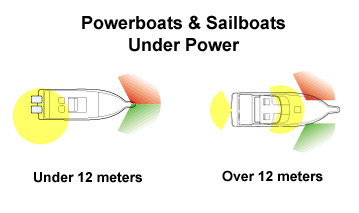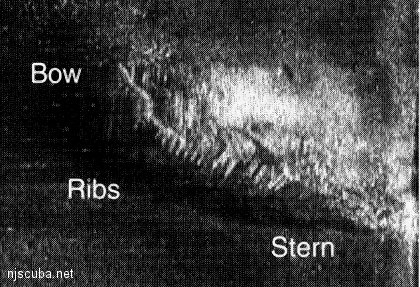Glossary of Terms
Port & Starboard
port - the left side of a ship, when facing forward
starboard - the right side of a ship, when facing forward

The starboard side of a vessel ( or an airplane ) carries a green running light, and the port side carries a red running light. The best way to remember all this is: port, left and red are all short words, while starboard, right, and green are all long(er) words.
The term starboard comes from the days a very long time ago when ships were steered not with a rudder but with a large oar or "steering board" trailed over the right side of the stern.
The left side of a ship was once called larboard, or "loading board". This was the side of the ship that was tied up to the dock for loading, thereby not encumbering the steering gear on the other side. To avoid confusion over the similarity between the two terms, the term port gradually replaced larboard.
The front of a ship is the bow, and the back is the stern. Of course, everybody knows that. The top edge of the hull is the gunwale, or "gunnel," while the back edge of the hull is the transom. And those holes in the side that let the water drain out from the deck are called "scuppers."
posh (posh) adj. 1. stylishly elegant; luxurious: a posh new restaurant. [ 1915-20; of obscure orig.; cf. posh a dandy (British slang of c1890) ]
-- from Random House Webster's Dictionary
The term posh is now a "backronym" for "port-outward starboard-home." What this means is that for a cruise from England to America, you should book a cabin on the sunny southerly port side of the ship for the trip west, and likewise on the starboard side for the return. From America to England and back would be "soph".
Vessel Tonnage
There are actually several different methods used to determine the tonnage of a vessel, some yielding vastly different results:
Displacement
the volume of water displaced by the vessel, estimated as 35 cu.ft. = 1 ton
Net Displacement
the weight of the vessel fully equipped but empty, without cargo, fuel, stores, crew, etc. This is the actual empty weight of the vessel.
Gross Displacement
the weight of the vessel when fully loaded, including the above. This is the maximum loaded weight of the vessel.
Deadweight
the weight a vessel can carry. The combined weight of cargo, stores, crew, etc. Equal to the difference between Net and Gross Displacement.
Gross Register
An estimate of the vessel's carrying capacity, based upon the total volume of all internal spaces, estimated as 100 cu.ft. = 1 ton
Net Register
This is the earning capacity of vessel, based upon the volume of the ship used to carry cargo and/or passengers. Equal to Gross Register less the non-earning spaces occupied by machinery, bunkers, water ballast, and crew.
Note: these measurements are generally expressed in "long tons" rather than standard tons. The difference is:
1 long ton = 2240 lbs.
1 standard ton = 2000 lbs.
It is difficult to know the real weight of something as large as a ship. You can't just put it on a scale. Designers try to estimate it by the amount of metal ( or wood ) they think they used. That must work better today with computer-aided design, but in old days, it was often a very rough approximation, and you didn't really know how a new design would float until you launched it.
Most dock and port charges are levied upon the Net Register. However, most references on shipping list the Deadweight, while the Lloyds Register of Shipping lists the Gross/Net Register and Deadweight. ( Lloyds Register consists of several volumes which list every vessel built, along with type, size, owner etc, and is the Bible of the shipping industry for insurance purposes. )
Thanks to diver Jerry Granberg of the dive boat CRT II for this information.

